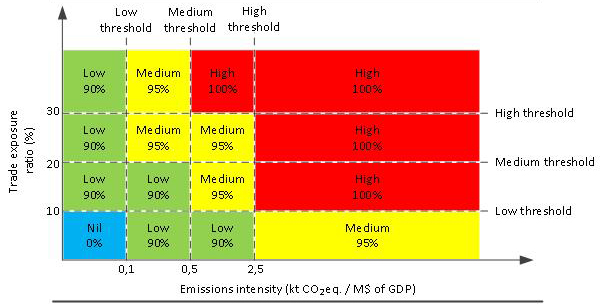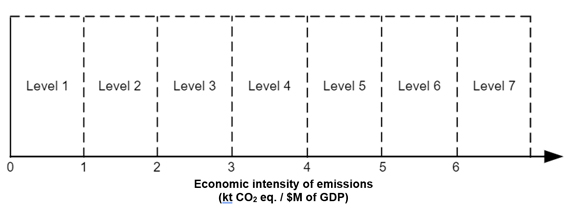
Carbon Market
Calculation Method Used to Determine the Quantity of Emission Units Allocated Free of Charge
The quantity of free emission units allocated annually to emissions-intensive trade-exposed (EITE) emitters is calculated on the basis of the actual quantity of reference units produced or used, their GHG emission intensity target (intensity target) and an assistance factor.
Number of free emission units = AF × (Intensity target × Quantity of reference units)
This approach, based on the actual production levels of EITE emitters, makes it possible to avoid penalizing a company that increases its production and not allocate too many free emission units to a company that reduces its production.
Implementation of the consignment mechanism
Starting in 2024, a new mechanism will be put in place that will allow a portion of the emission units constituting the free allocation granted to be consigned and sold at auction. The sums resulting from the auction will be set aside on behalf of the emitter to contribute to the climate transition through projects to reduce GHG emissions as well as through research and development projects in this area.
Total free allocation
Starting in 2024, the amount of emission units allocated annually to EITE emitters will be calculated based on the actual quantity of reference units produced or used, their GHG emissions intensity target (intensity target), an assistance factor, and a factor corresponding to the minimal expected effort (MEE) of reduction for all emitters.
Number of free emission units = Intensity target x Quantity of reference units x (AF – MEE)
The minimal expected effort (MEE) corresponds to the annual reduction of the allocation that cannot be converted into emission units that are to be auctioned.
The quantity of emission units allocated free of charge to EITE emitters will be granted in two parts: the free allocation paid to the emitter and the emission units to be sold at auction.
The free allocation paid to the emitter
The free allocation paid to emitters corresponds to the portion of the free allocation paid in the form of emission units. It is calculated based on the actual quantity of reference units produced or used, their GHG emissions intensity target (intensity target), an assistance factor and reduction factors (CDF, EEE and TMF – see next section).
Number of emission units paid to the emitter = Intensity target ×
Quantity of reference units x (AF – CDF – EEE – TMF)
Emission units to be sold at auction
A portion of the emission units allocated to EITE emitters is intended for auction. Revenues from the auctioning of these emission units are set aside on behalf of the emitters to support them in their climate transition and carry out projects to reduce GHG emissions or research and development projects.
Number of emission units intended for auction = Number of free emission units – Number of emission units paid to the emitter
Intensity targets
As a general rule, intensity targets are established based on the quantity of GHG emissions declared per reference unit during a reference period, i.e., the levels observed between 2007 and 2010, and are expressed in tons of CO2 equivalent (t CO2 eq.) per reference unit.
The intensity targets* were set taking into account the different types of GHGs emitted by companies (combustion, fixed process or other, primarily fugitive, emissions) and, consequently, the various reduction possibilities available to them.
* For most establishments, intensity targets are calculated on an individual basis. However, intensity targets for the aluminum, lime and cement sectors are based on sectoral averages since it is possible to determine targets on the basis of the performance achieved by all establishments in the sector.
For the first compliance period (2013-2014), intensity targets were set at 100% of historic averages for fixed process emissions and other (primarily fugitive) emissions. For combustion emissions, targets were set between 80 and 100%, depending on the fuels used.
Between 2015 and 2020, intensity targets for fixed process emissions remain at 100%, while targets for combustion emissions and other emissions decrease by 1 to 2% annually in order to encourage companies to make improvements.
For the 2021-2023 period, intensity targets for fixed process emissions, combustion emissions and other emissions decrease respectively by 0.5, 1.5 and 3% annually.
For the 2024-2030 period, intensity targets are determined based on the intensity targets set for 2023 as well as the emission levels observed between 2017 and 2019. No distinction is made for the different types of emissions.
Similar rules apply to new emitters and those who decide to voluntarily opt into the system, with reference years adapted based on the year in which they reach the reporting threshold or the year during which they submit a voluntary opt-in application.
Assistance factors
The number of free emission units distributed to each establishment is then adjusted according to the emitter’s assistance factor (AF), which depends on the carbon leakage risk level estimated for its sector of activity. Until 2020, the AF of all EITE emitters has been set at 100%.
For the 2021-2023 period, AFs will vary depending on the estimated carbon leakage risk. The latter varies depending on the combination of the trade exposure ratio measurement and emission intensity measurement previously described. The following chart shows the classification that was chosen.
Note that for EITE emitters, the AFs vary from 90 to 100% under this classification.
An AF of 60% has been retained under certain conditions for the electricity sector, while the AF for other cases is zero (0).
Assistance factor as a function of carbon leakage risk

Reduction factors
For the 2024-2030 period, the values of these factors are common to all EITE emitters or are specific to each establishment depending on the carbon leakage risk level determined.
- Minimal expected effort (MEE)
An annual decrease equivalent to 1 percentage point (pp) is applied to the total allocation of each EITE emitter. Any annual reduction exceeding this 1 pp is converted into emission units for auction. - Cap decline factor (CDF)
A reduction in the free allocation granted to the emitter corresponding to the annual decrease in Québec’s emission caps, i.e., 2.34 pp, is applied each year for all EITE emitters. Extra effort expected (EEE)
A reduction in the free allocation granted to the emitter, determined on the basis of its carbon leakage risk level, is applied each year. This reduction varies from 0 to 1.36 pp annually.Ranking of companies based on the importance of emissions in the value creation process

- Proportion factor of fixed process emissions (FFP)
When the majority of emissions are fixed process emissions (50% of total emissions), the extra effort expected (EEE) is reduced by 0.272 pp annually. - Trajectory modulation factor (TMF)
A modulation factor whose value varies between -1.25 pp and 0 pp during the 2024-2030 period is applied to all EITE emitters. This factor makes it possible to mitigate the reduction effort during the first years of the 2024-2030 period in order to take into account Québec’s lead in carbon pricing and thereby preserve the competitiveness of Québec businesses.
All equations used to calculate free allocations are specified in the Regulation respecting a cap-and-trade system for greenhouse gas emission allowances. In addition, an Excel tool
(French, ![]() Excel, 194 KB) is available for emitters to facilitate the calculation of the expected free allowances and consigned funds for their establishments.
Excel, 194 KB) is available for emitters to facilitate the calculation of the expected free allowances and consigned funds for their establishments.
